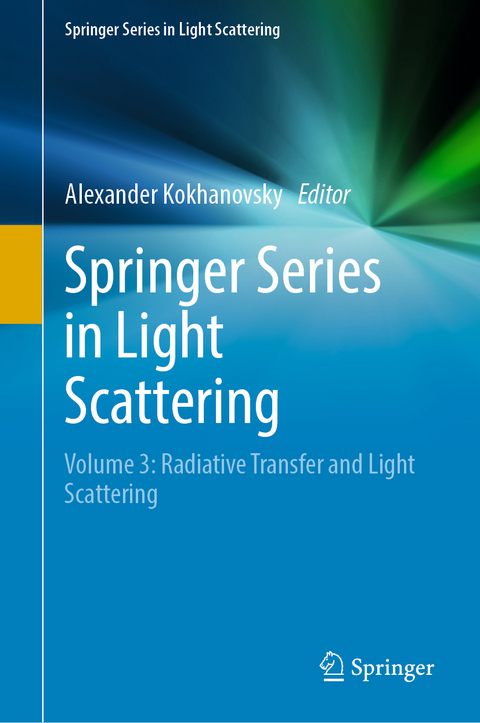
Springer Series in Light Scattering
Springer International Publishing (Verlag)
978-3-030-03444-3 (ISBN)
Alexander Kokhanovsky graduated in 1983 in Theoretical Physics (The Department of Physics, Belarusian State University, Minsk, Belarus): the main topics of his thesis was the solution of the vector radiative transfer equation for the case of chiral light scattering media. Particular attention was given to the study of the properties of radiation in deep layers of a turbid medium under study. The phase and extinction matrices have been calculated using the Maxwell theory for chiral spheres. In 1983, Dr. Kokhanovsky joined the Laboratory of Light Scattering Media of the Institute of Physics of National Academy of Sciences of Belarus as a Junior Research Scientist. In 1986, he started a Ph.D. course in Optics at the Institute of Physics (National Academy of Sciences of Belarus, Minsk, Belarus). During the Ph.D., his focus rapidly moved to studies of Atmospheric Optics, in particular to the investigation of atmospheric aerosol and clouds using optical methods. As a Ph.D. student he was responsible for several projects related to studies of light propagation and image transfer through atmosphere and ocean. The optical properties of whitecaps have been studied as well. In December 1991, he was awarded the Ph.D. degree in Optics for the thesis "Optical Properties of Atmospheric Aerosols and Foams". Simple analytical equations have been proposed for radiative characteristics of coarse-mode aerosols, water clouds, and foams in terms of the parameters of microstructure such as size distribution, shape, internal structure, and chemical composition of scatterers. After the Ph.D. defense Dr. Kokhanovsky has focused his research on the development of fast algorithms to retrieve cloud properties using satellite observations. He also studied several inverse problems of light scattering media optics including the diffuse-wave spectroscopy and laser diffraction spectrometry. In 1994, Dr. Kokhanovsky was awarded the Science and Technology Agency of Japan Fellowship to work at the National Space Development Agency (NASDA) of Japan on cloud remote sensing. He spent one year (1996) in Tokyo (Earth Observation Research Center) working in the group of Prof. Teruyuki Nakajima in the area of cloud and snow remote sensing using spaceborne observations (GLI/ADEOS). Afterwards he was awarded the Alexander von Humboldt Fellowship (Clausthal University, Clausthal-Zellerfeld, Germany, 1998) and Engineering and Physical Sciences Research Council Fellowship (Imperial College London, UK, 1999), where he developed novel techniques to derive properties (e.g., particle size distribution) of light scattering particles using small-angle and polarimetric optical measurements. Also, the tensor radiative transfer equation was derived. This equation has been proved to be useful in studies of light propagation in anisotropic media.
The LIDORT and VLIDORT Linearized Scalar and Vector Discrete Ordinates Radiative Transfer Models.- Radiative Transfer of Light in Strongly Scattering Media.- Polarized Radiation Transport Equation in Anisotropic Media.- Aerosol Layer Height Over Water via Oxygen A-band Observations from Space: A Tutorial.- Optical Properties of Black Carbon Aggregates.
| Erscheinungsdatum | 26.01.2019 |
|---|---|
| Reihe/Serie | Springer Series in Light Scattering |
| Zusatzinfo | VII, 221 p. 51 illus., 42 illus. in color. |
| Verlagsort | Cham |
| Sprache | englisch |
| Maße | 155 x 235 mm |
| Gewicht | 514 g |
| Themenwelt | Naturwissenschaften ► Geowissenschaften ► Geografie / Kartografie |
| Naturwissenschaften ► Physik / Astronomie ► Elektrodynamik | |
| Naturwissenschaften ► Physik / Astronomie ► Optik | |
| Technik ► Umwelttechnik / Biotechnologie | |
| Schlagworte | black carbon aggregates • Chiral Media • polarized radiative transfer in terrestrial media • Remote Sensing • Remote Sensing/Photogrammetry • spectro-polarimetry of particulate media |
| ISBN-10 | 3-030-03444-5 / 3030034445 |
| ISBN-13 | 978-3-030-03444-3 / 9783030034443 |
| Zustand | Neuware |
| Haben Sie eine Frage zum Produkt? |
aus dem Bereich


